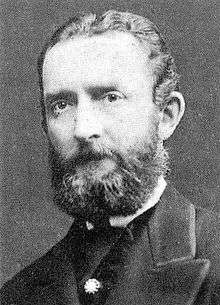Prince Johann of Schleswig-Holstein-Sonderburg-Glücksburg
Prince Johann of Schleswig-Holstein-Sonderburg-Glücksburg (5 December 1825 – 27 May 1911) was the ninth of the ten children of Friedrich Wilhelm, Duke of Schleswig-Holstein-Sonderburg-Glücksburg and Princess Louise Caroline of Hesse-Kassel. He was named after his ancestor John II, Duke of Schleswig-Holstein-Sonderburg.[1][2]
| Prince Johann | |
|---|---|
 | |
| Born | 5 December 1825 Gottorp, Schleswig, Duchy of Schleswig |
| Died | 27 May 1911 (aged 85) Yellow Palace, Copenhagen, Denmark |
| House | Glücksburg |
| Father | Friedrich Wilhelm, Duke of Schleswig-Holstein-Sonderburg-Glücksburg |
| Mother | Princess Louise Caroline of Hesse-Kassel |
| Signature | |
Biography
As per the wishes of his cousin King Christian VIII, Prince Johann first enlisted in the Prussian military in 1842 and upon his graduation was appointed Second Lieutenant of the 27th Prussian Infantry Regiment in Magdeburg. He studied at the University of Bonn before joining the Dragoon Guards Regiments in Berlin. He participated in the German revolutions of 1848–1849 and the First Schleswig War against Denmark; this conflict of loyalties between Prussia and Denmark prompted him to request exemption from service.[3] He went on to serve in various departments and was promoted to Rittmeister in 1854. The following year he was appointed Major à la suite and went to Denmark, settling down in Copenhagen.[2]
When the Second Schleswig War broke out in 1864, Johann resigned from the Prussian army, and on 29 February his brother — now King Christian IX of Denmark — appointed him Lieutenant Colonel à la suite in the Danish Army. He went on to represent Denmark on diplomatic visits abroad, and was present in London during the baptism of the Prince of Wales' eldest son, the future George V of the United Kingdom. He was promoted to Colonel in 1865, and further to Major-general in 1867.[2]
From March to November of 1867 he served as regent for his nephew, King George I of Greece during the Cretan uprising, when the latter was away on a tour of Europe in search of a bride;[2] he soon grew popular among the people.[4]
Johann died unmarried in 1911, outliving the rest of his siblings. He was interred at Roskilde Cathedral.
Titles, styles and honours
Titles and styles
- 5 December 1825 – 19 December 1863: His Serene Highness Prince Johann of Schleswig-Holstein-Sonderburg-Glücksburg
- 19 December 1863 – 27 May 1911: His Highness Prince Johann of Schleswig-Holstein-Sonderburg-Glücksburg
Honours

- Knight of the Elephant, 9 March 1864
- Cross of Honour of the Order of the Dannebrog, 9 March 1864
- Commemorative Medal for the Golden Wedding of King Christian IX and Queen Louise, 1892
- Grand Cross of the Dannebrog, 12 February 1894

.svg.png)
.svg.png)

.svg.png)
.svg.png)

- Knight of the Seraphim, 27 July 1869[7]
- Knight of the Order of Charles XIII, 21 January 1877[8]
- Grand Cross of St. Olav, 12 February 1879[9]
.svg.png)

- Knight of St. Andrew
- Knight of St. Alexander Nevsky
- Knight of the White Eagle
- Knight of St. Anna, 1st Class
- Knight of St. Stanislaus, 1st Class
Ancestry
References
- Bramsen, p. 105
- Dansk Biografisk Leksikon (in Danish), 6 (1 ed.), 1892, pp. 568–569, retrieved 3 July 2020 – via runeberg.org
- Bramsen, p. 106
- Driault, Edouard; Lhéritier, Michel (1926). Histoire diplomatique de la Grèce de 1821 à nos jours (in French). Paris. p. 235.
- Bille-Hansen, A. C.; Holck, Harald, eds. (1901) [1st pub.:1801]. Statshaandbog for Kongeriget Danmark for Aaret 1901 [State Manual of the Kingdom of Denmark for the Year 1901] (PDF). Kongelig Dansk Hof- og Statskalender (in Danish). Copenhagen: J.H. Schultz A.-S. Universitetsbogtrykkeri. pp. 4, 7. Retrieved 3 July 2020 – via da:DIS Danmark.
- Hof- und Staats-Handbuch des Herzogtum Anhalt (1867) "Herzoglicher Haus-orden Albrecht des Bären" p. 16
- Sveriges Statskalender (in Swedish), 1881, p. 377, retrieved 2020-07-03 – via runeberg.org
- Anton Anjou (1900). "Utländske Riddare". Riddare af Konung Carl XIII:s orden: 1811–1900: biografiska anteckningar (in Swedish). p. 178.
- Norges Statskalender (in Swedish), 1890, pp. 593–594, retrieved 2018-01-06 – via runeberg.org
Bibliography
- Bramsen, Bo (1993). Huset Glücksborg. Europas svigerfader og hans efterslægt (in Danish) (2 ed.). Copenhagen: Rosinante & Co. ISBN 87-553-1843-6.